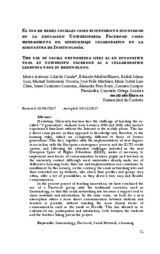Mostrar el registro sencillo del ítem
El uso de redes sociales como instrumento innovador en la educación universitaria: Facebook como herramienta de aprendizaje colaborativo en la asignatura de Inmunología
| dc.contributor.author | Calzado Canale, Marco Antonio | |
| dc.contributor.author | Muñoz Blanco, Eduardo | |
| dc.contributor.author | Solana Lara, Rafael | |
| dc.contributor.author | Santamaría Ossorio, Manuel | |
| dc.contributor.author | Peña Martínez, José | |
| dc.contributor.author | Lara Chica, M. Isabel | |
| dc.contributor.author | Cantarero, Irene | |
| dc.contributor.author | Pera Rojas, Alejandra | |
| dc.contributor.author | Campos Fernández, Carmen | |
| dc.contributor.author | Ortega Gromaz, Consuelo | |
| dc.date.accessioned | 2018-06-12T12:29:57Z | |
| dc.date.available | 2018-06-12T12:29:57Z | |
| dc.date.issued | 2018 | |
| dc.identifier.issn | 2531-1336 | |
| dc.identifier.uri | http://hdl.handle.net/10396/16919 | |
| dc.description.abstract | En la actualidad los docentes universitarios tienen el reto de enseñar a la conocida como “generación Y”, alumnos nacidos entre los años 1980 y 2000, los cuales no han conocido el mundo sin internet o teléfono móvil. Esto por supuesto implica que el acercamiento al conocimiento, y por tanto los modos de aprendizaje, son completamente diferentes a los de generaciones anteriores. Esto unido a la implementación de las nuevas titulaciones acordes con el proceso de convergencia europea y el sistema de créditos ECTS, y siguiendo los desafíos de la enseñanza contemplados en el Espacio Europeo de Educación Superior (EEES), hace inevitable la implementación de nuevas formas de comunicación entre los alumnos y los profesores en el ámbito Universitario. Aunque en este aspecto la mayoría de las Universidades cuentan ya con diferentes herramientas de e-Learning, su uso e implementación en algunas ocasiones puede resultar insuficiente. En este escenario, por el contrario, son muchas las posibilidades que ofrecen las redes sociales y su extenso uso entre el alumnado, quien accede generalmente con mucha frecuencia a sus perfiles y grupos, proporcionando una comunicación rápida, fácil y flexible. En el presente proyecto de innovación docente hemos combinado el uso de un grupo de Facebook con los recursos tradicionales en la docencia relativa a la asignatura de Inmunología, usando esta red social como herramienta de apoyo para compartir materiales e información. Todo ello buscando un nuevo ambiente de comunicación más directo entre alumnos y profesorado, sin por supuesto tener que sustituir las vías de comunicación formales como el correo electrónico y Moodle. Esto nos ha permitido evaluar su uso, participación y satisfacción entre el alumnado que ha participado en el proyecto. | es_ES |
| dc.description.abstract | Nowadays, University teachers face the challenge of teaching the so-called “Y generation”, students born between 1980 and 2000, who haven't experienced their lives without the Internet or the mobile phone. This has a direct consequence on their approach to knowledge and, therefore, to the learning styles, which are completely different to those of former generations. This fact, together with the implementation of new degrees more in line with the European convergence process and the ECTS credit system, and following the educative challenges included in the new European Space of Higher Education (EEES), makes it necessary to implement new forms of communication between pupils and teachers in the university context. Although most universities already make use of different e-Learning tools, their use and implementation can sometimes be insufficient. In this scenery, on the contrary, the social networking sites and their extended use by students, who check their profiles and groups very often, offer a lot of possibilities, as they allow a fast, easy and flexible communication. In the present project of teaching innovation, we have combined the use of a Facebook group with the traditional resources used in Immunology, so that this social networking site becomes a support tool to share materials and information. In the same sense, we look for a new atmosphere where a more direct communication between students and teachers is possible, without avoiding the more formal forms of communication such as the email or Moodle. This has allowed us to evaluate its use, participation and satisfaction, both between the students and the teachers taking part in the project. | es_ES |
| dc.format.mimetype | application/pdf | es_ES |
| dc.language.iso | spa | es_ES |
| dc.publisher | UCOPress | es_ES |
| dc.rights | https://creativecommons.org/licenses/by-nc-nd/4.0/ | es_ES |
| dc.source | Revista de innovación y buenas prácticas docentes 4, 32-48 (2018) | es_ES |
| dc.subject | Inmunología | es_ES |
| dc.subject | es_ES | |
| dc.subject | Redes sociales | es_ES |
| dc.subject | e-Learning | es_ES |
| dc.subject | Immunology | es_ES |
| dc.subject | es_ES | |
| dc.subject | Social network | es_ES |
| dc.subject | e-learning | es_ES |
| dc.title | El uso de redes sociales como instrumento innovador en la educación universitaria: Facebook como herramienta de aprendizaje colaborativo en la asignatura de Inmunología | es_ES |
| dc.title.alternative | The use of social networking sites as an innovative tool at university: Facebook as a collaborative learning tool in Immunology | es_ES |
| dc.type | info:eu-repo/semantics/article | es_ES |
| dc.relation.publisherversion | http://www.uco.es/ucopress/ojs/index.php/ripadoc/index | es_ES |
| dc.rights.accessRights | info:eu-repo/semantics/openAccess | es_ES |

